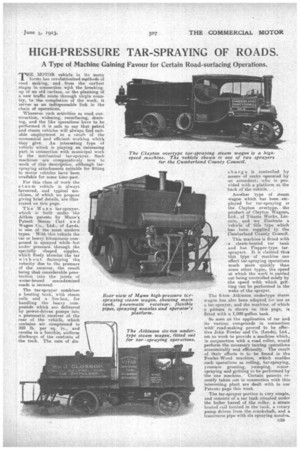HIGH-PRESSURE TAR-SPRAYING OF ROADS.
Page 23

If you've noticed an error in this article please click here to report it so we can fix it.
A Type of Machine Gaining Favour for Certain Road-surfacing Operations.
THE MOTOR vehicle in its many forms has revolutionized methods of road making, and from the earliest stages in connection with the breaking
up of an old surface, or the planning of a new traffic route through virgin courttry, to the completion of the work, it serves as an indispensable link in the chain of operations.
Wherever iinch activities as road construction, widening, resurfacing, drain ing, and the like operations have to be performed it is safe to say that petrol and steam vehicles will always find suit, able employment as a result of the economical and efficient working which . they give. An interesting type of vehicle which is playing an increasing part in connection with municipal work is the mechanical tar-sprayer. Such machines are comparatively now to For this class of work the at m vehicle is always favoured, and typical machines, of which we propose giving brief details, are illustrated on this page.
The Mann tar-sprayer. which is built ander the Aitken patents by Malin's Patent Steam Cart an d Wagon Co., -Ltd., of Leeds', is one. of; the -most modern types. With this vehicle the tar or heavy bituminous couF pound is sprayed while hot under pressure through the specially shaped nipples, which finely atomize the tar with out destroying' the velocity due to the pressure of the receiver, the result being that censiderable pens tuition into the joints of water-bound macadamized roads is secured.
The tar-sprayer combines a heating tank, with steam coils and a fire-box, for -handling the heavy compounds which are delivered by power-driven pumps into a pneumatic receiver at the rear of the vehicle, which contains air compressed to 200 lb. per sq. iii., and results in a forcible, uniform discharge of the contents of the tank. The rate of die
c ha r g e is controlled by means of cocks operated by an attendant, who is provided with a platform at the hack of the vehicle.
Another type of steam wagon which has been einployed for tar-spraying is the Clayton overtype, the product of Clayton Wagons, Ltd., of Titanic 'Works, Lincoln, and we illastrate 'vehicle' ofthis -type which has . been, supplied to the Cumberland County .Council.
This machine is fittedwith • a steam-heated tar tank
• and has Flapper-type tarsprayers. It is claimed thai this type of machine ca-n effect tar-spraying operations much more .quickly than some other types, the speed at which the work is carried out being controlled solely by ,the speed with which gritting can be performed in the wake of the sprayer.
The 6-ton Atkinson undertype steam wagon has also been adapted, for use as a tar-sprayer, and the machine, of which a . picture is shown on this page, is fitted with a 1,000-gallon tank.
So sopa as the application of tar and its various compounds in connectiort with road-making proved to be effective John Fowler and Co. (Leeds), Ltd., set to work to provide a marline which. in conjunction with a road roller, would perform the necessary tarring operations economically and efficiently. The result of . their efforts is to be found in tbq Fowler-Wood machine, which enables such operations as rolling, tar-spraying, pressure grouting, sweeping, waterspraying and gritting to be performed by the one machine. Certain patents recently taken out in connection with this interesting plant are dealt with in our Patents page this week.
The tar-sprayer portion is very simple, and consists of a. tar tank situated under the boiler barrel of the roller, a steam heated coil located in the tank, a rotary pump driven from the crankshaft, and a transverse pipe with six spraying nozzles.








































